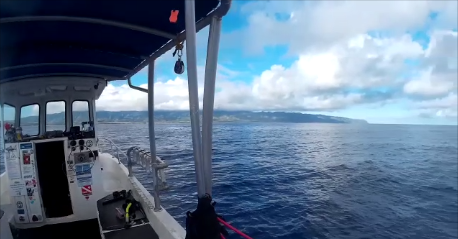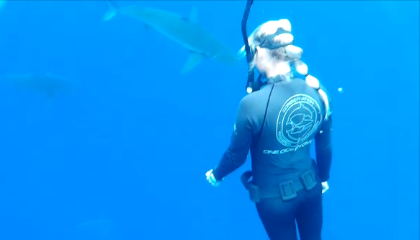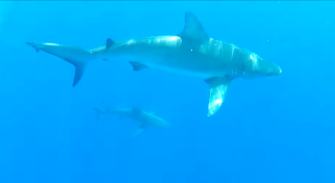I admit I have had an irrational lifelong fear of sharks, like most people, due to negative exposure by the media and Hollywood. I have only ever observed small nurse sharks outside of an aquarium setting, but have really wanted to see other species in the open water--to witness their grace, power, and intelligence. My husband and I chose to accompany One Ocean Diving on one of their Pelagic Shark Program trips for a few reasons: they promote conservation; they educate about the importance of sharks to our oceans; they conduct vital research on several pelagic species; and they offer a cage-free experience so that you can interact with the animals in a natural setting.

A view of the North Shore of Oahu from the Pono Kai, the dive boat operated by One Ocean Diving. Photo credit: Michael O'Ross.
Conditions were near perfect, with minimal chop on the water, no wind, and partial cloud cover. Captain Kevin left the marina in a small dive boat carrying six clients and our safety diver and educator, Jules. On the way to the dive site, Jules provided a wonderful tutorial on shark behavior, inclusive of important information regarding body language, posturing, agnostic displays, and how to tell if your dominance in the water is being challenged by a shark (and what to do about it if it is). Jules's enthusiasm and passion for shark conservation is contagious.
Swimming with sharks on purpose and without a barrier (a cage, plexiglass, or SOMETHING), goes against everything in me. I really had to train the brain for a few weeks prior to our adventure in order to prepare for the moment of water entry. I had watched many of the videos from prior programs and tried to visualize myself in the water with these beautiful and very large apex predators.
The mooring used for trips is strategically placed on the first shelf, which is approximately 300 feet deep. The sharks favor certain areas based on currents and the depth of water. Upon approach of the mooring buoy, the boat engines provided turbulence and formed bubbles at the surface, which initially excites the sharks. Several dorsal fins crested the water, which excites the divers. Jules, our safety diver, entered the water first to see how many sharks were present and to initially judge their mood. Many of the sharks are personally known to the crew because of distinctive scars or marks. Jules was very excited that we would be in the presence of Phillip, a 10 feet Galapagos shark. Phillip is a female, by the way. There were 13 Galapagos sharks present in total during our time at the dive site.

Jules Hartl, One Ocean Diving's safety diver, maintains eye contact with Galapagos sharks. Photo credit: Michael O'Ross.
Galapagos sharks are schooling sharks, and as such, have a distinctive pecking order defined by the depth at which they swim. The sharks we observed swam in a spiraled pattern known as a social hierarchy, with the most submissive sharks at the bottom and the most dominant sharks at the top. As swimmers in their territory, it was critical that we humans maintain space in water ABOVE the most dominant sharks, in order to tell them that we are non-prey dominant large animals.
Apprehensively, I entered the water after everyone else had been in for several minutes. Seeing multiple dorsal fins above the water and dark shadows below the waterline moments before made me question my judgment. Hanging tightly to the safety ropes dangling from the boat in a mild shark-induced catatonic state, I scanned the water in all directions, truly in disbelief that sharks were all around me. I kept a careful watch and maintained eye contact with any shark in my vicinity (especially Phillip).
These are a few of the key feelings that I can try to verbalize after swimming with these amazing creatures (in order of most- to least-profound):
DISAPPOINTMENT: It is hard to explain, but I felt a strong disappointment in humanity after only a few minutes. Why aren't we doing more to protect these apex predators from the vile and unsustainable shark finning industry, which is responsible for more than 100 million shark slaughters every year? It was really sad to realize that some of the sharks I was with could be taken for their fins in the future. I was also disappointed that three of the sharks carried injuries from fishing line and hooks--scars and damaged fins, trailing line still attached, and large fishing hooks still in place.
RESPECT: Observing natural shark behavior for the first time is overwhelming, especially when there is no barrier between you and a hunter. However, by following the rules of the game (primarily, maintaining eye contact and presence above the sharks in the water column), mutual respect is achieved. It is both empowering and humbling to feel a connection with a shark in the water.
UNEASE: Fear is NOT what I was feeling but I can't honestly say that swimming in the presence of sharks was relaxing. We were in the company of shark experts who were extremely professional and watchful of any behavioral changes. But my shark education consisted of a 15 minute crash course on the boat ride out, so I felt uneasy that I was unintentionally ignoring critical communication (in the form of body language) from an approaching shark. The largest and most dominant shark, Phillip, liked to approach alarmingly close (as in, three feet). Seeing her eyes scan my silhouette as she passed made me tense, but I trusted that Phillip was merely being curious.
Being in the presence of thirteen powerful, graceful, intelligent, and wild Galapagos sharks in their house was a life-altering experience. I would be lying if I told you that I won't still suffer from some anxiety in the ocean, but it will be a fear of the unknown rather than a precise fear of a shark encounter. After all, I am much more likely to be ruthlessly attacked by jellyfish. Fear not the signs at the beach that say "Shark Sighted." What all of us should fear is an ocean without any sharks in it.
Video clips captured by the author's husband. Credit: Michael O'Ross.
